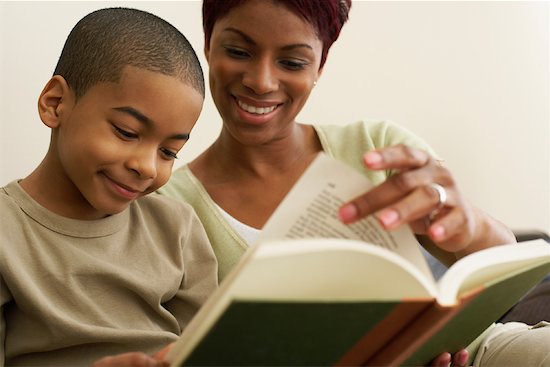
by PRIDE Reading Program Admin | Jun 5, 2016 | A PRIDE Post, Reading Fluency
Once a child is able to decode and recognize words in print, it is crucial that they also gain an ability to read smoothly and fluently. Stumbling and hesitating over words will undermine reading comprehension because by the time the child gets to the end of a sentence he or she will have completely forgotten what was at the beginning of the sentence!
How do you measure reading fluency in your child?
- Ask the child to read a grade level passage that they have never seen or read before.
- Using a timer have him or her read this text for one minute.
- While reading the passage, tally the errors the child makes while reading.
- Stop the child after one minute. Count the number of words read in the minute and subtract any errors made by the child. For example: if he or she read 120 words in a minute and made five errors then the child’s reading fluency rate is 115.
- Use the chart below to determine if your child’s reading rate is on target.
Mean Words Correct Per Minute “Targets” for Average Students in Grades One through Eight
| Grade | Fall Target | Winter Target | Spring Target |
| | | |
| 1 | Not applicable | 20 | 50 |
| 2 | 50 | 70 | 90 |
| 3 | 70 | 90 | 110 |
| 4 | 95 | 110 | 125 |
| 5 | 110 | 125 | 140 |
| 6 | 125 | 140 | 150 |
| 7 | 125 | 140 | 150 |
| 8 | 130 | 140 | 150 |
Johns, J. and Berglund, R. (2006). Fluency strategies and assessments. Dubuque, IA: Kendall/Hunt Publishers.
How do you determine a child’s reading level to test for fluency?
Probably the easiest ways to determine if a book is at an appropriate reading level for your child is the Five Finger Rule. Have the child begin reading a chapter, and put down one finger each time he struggles with a word. If he reaches the end of the page before you get to five fingers, the book is written at a comfortable level for independent reading.
What can you do to increase and improve your child’s reading fluency?
The very best way is through practice, both through oral and silent reading.
One approach to practicing reading fluency is for the child to repeatedly read the same passage or text either with a parent or teacher three to four times. Rereading text gives the child multiple opportunities to read unfamiliar words. After repeated reading, those words become familiar. The child should practice rereading aloud texts that are reasonably easy for them and at their reading level and include words that the child already knows and can decode easily. A text is considered at reading level if the child can read it with 95% accuracy. This text should also be relatively short consisting of 50-200 words. First, the parent or teacher reads the text aloud to the student. Then the student reads the same passage to the adult or chorally with the adult. Finally, the student rereads the passage again independently.
Reading frequently will also improve reading fluency since reading is a skill that improves with practice. Children can improve their reading fluency by reading independently each day for at least 20 minutes. Again it is important that the child read a book or text that is at their grade level or slightly below their grade level. Children should be encouraged and allowed to read a book of their choice – even if this doesn’t involve classic novels for their independent reading. For gaining fluency, quantity is more important than quality. Whenever possible, use their interests to guide their reading choices and give them some power in making decisions about what to read.
Memorizing Dolch sight words is another method to improve reading fluency in children. By memorizing common words like “the”, “said”, “what”, “you”, the child will read texts and stories more fluently. Many of these words are in almost anything they read. Readers will have more experiences of success if they know these words. Dolch words are service words; they give meaning and direction, which are necessary for understanding sentences.
Model good reading for your children. Share what you read with them or read what they are reading. Have discussions and talk to them about the things you find important in what you read and why. Parents and teachers need to read themselves and read in front of their children and students. Children will imitate you and will be more likely to read and read well in a house and classroom filled with all kinds of interesting books, magazines and texts.
Learn more about the New PRIDE Reading Program
___________________________________________________________________________________________
Karina Richland is the Founder of Pride Learning Centers, located in Los Angeles and Orange County. Ms. Richland is a certified reading and learning disability specialist. Ms. Richland speaks frequently to parents, teachers, and professionals on learning differences, and writes for several journals and publications. You can reach her by email at karina@pridelearningcenter.com or visit the Pride Learning Center website at: www.pridelearningcenter.com

by PRIDE Reading Program Admin | May 26, 2016 | A PRIDE Post, Reading Comprehension
Is your child having difficulties with reading comprehension? Need a reading comprehension strategy that helps your child understand what they have just read?
Well, try using the SWBS reading comprehension strategy. It is our favorite reading comprehension strategy.
Somebody – Wanted – But – So
The SWBS is a fantastic and easy to implement reading comprehension strategy that helps children understand plot elements such as conflicts and resolutions. It also allows the child to summarize the elements of a story and develop the summary into a retelling of the story. It can be used as a “during reading” or “after reading” strategy. I also like to use it as a quick reading comprehension assessment with my students.
The SWBS reading comprehension strategy is basically a summarizing technique. Summarization requires a student to pull out the main idea, focus on key details, use key words and phrases, and break down the larger ideas. Summarizing is an extremely difficult task for most students. Many children require instruction and practice in summarizing before they are able to produce good oral and written summaries of text. The SWBST strategy helps children first orally summarize what they have read and then put the summary down onto paper into paragraph form. It works with both fiction and nonfiction text. So here is how it goes:
Somebody – Wanted – But – So
Procedure:
1. Have your child read a story (independently or with help is fine)
2. Write down the following:
Somebody…
Wanted…
But…
So…
3. Fill in the sentences together with your child relating to the story that they just read. Somebody relates to the character of the story. Wants is the goal or motivation that the character exhibits. But refers to the conflict in the story. So is the resolution of the conflict. Do it first orally then in written form.
4. Have your child write out the sentences in a paragraph form. Younger students can add just one sentence while older students can add detail with 1-3 sentences.
It is AWESOME – right? The key to getting your child to memorize this summary form is through repetition. Doing it just one time won’t work. Doing it all year long – it will “stick.” Good Luck and let me know how it goes…

Learn more about the New PRIDE Reading Program
___________________________________________________________________________________________
Karina Richland, M.A. is the Founder and Director of PRIDE Learning Centers, located in Los Angeles and Orange County. Ms. Richland is a certified reading and learning disability specialist. Ms. Richland speaks frequently to parents, teachers, and professionals on learning differences, and writes for several journals and publications. You can reach her by email at karina@pridelearningcenter.com or visit the PRIDE Learning Center website at: www.pridelearningcenter.com

by PRIDE Reading Program Admin | Feb 15, 2016 | A PRIDE Post, Learning Disabilities, Reading Comprehension, Reading Skills
Reading is a highly complex, integrated activity that daunts as many as 33 percent of the population. Many children become proficient readers regardless of how they are taught. However, for children who experience difficulty learning to gain meaning from print, reading must be systematically and carefully taught. Mastering the following components of the reading process is essential if students are to become proficient readers.
Appreciation and enthusiasm for reading
It comes as no surprise that children who are passionate about reading are more skillful readers. Reading is more exciting to students when they are:
Read to frequently
Allowed to choose their reading material
Exposed to a wide variety of interesting reading materials
Phonemic awareness
Successful reading depends upon understanding that words are composed of individual sounds. Children need direct teaching in the skills of breaking words into their component sounds and in blending individual sounds together into words. Phonemic awareness is one of the most important skills upon which early reading depends. Children who have poorly developed phonemic awareness skills are at great risk for becoming poor readers.
Phonics and Decoding
Letters of the alphabet are a code representing the sounds in words. Reading involves “decoding” or translating written words into their spoken equivalents. The early stage of decoding instruction emphasizes the correspondence between individual letters or pairs of letters (such as “oa”) and the sounds they represent. Later reading instruction stresses rapid identification of larger units such as syllables. Identifying larger phonetic elements is termed structural analysis. Once a student learns the correspondence between sounds and print, he or she has become a proficient decoder.
Fluent, Automatic Reading of Text
However, in order to become an efficient reader, the decoding process must become fast and accurate. When decoding is efficient, attention and memory processes are available for comprehending what is being read. Reading fluency training is vital for strengthening a student’s comprehension skills. Children should have ample practice reading material that is not difficult for them to decode. This level is referred to as the “independent reading level.” Frequent reading of material at a child’s independent reading level builds automatic word recognition and frees up a child’s mental abilities for comprehension.
Background Knowledge
Comprehension depends heavily on a student’s knowledge of the world. Therefore, the skill of reading comprehension begins to develop long before children enter school. Children who have more experiences of all types, have more background knowledge upon which to base their understanding of written material. Parents help their child develop reading skills when they visit the museum, the park and even the store. Parents and teachers should also read to students in order to help them create a stockpile of information that will facilitate reading comprehension. The best reading instruction teaches a student to access background knowledge while reading.
Vocabulary
Comprehension depends on having a large vocabulary. Children who read widely learn word meanings at a faster rate than children whose reading is more limited either in scope or quantity. During their school years, children should be learning several thousand new words per year. Most of these words are learned by reading.
Written Expression
Reading and writing are two sides of the same coin. Effective reading instruction must include training in expressing one’s thoughts in writing. Children should be given daily practice in organizing and expressing their knowledge through writing. This builds their ability to decode and comprehend the thoughts of other writers.
The key to helping students who experience difficulty in learning to read is to identify a student’s specific reading problems and devise programs which capitalize upon a student’s unique learning strengths. A curriculum that focuses on specific, appropriate, and practical learning strategies will best help students become proficient, efficient and independent readers.
An appropriate literacy goal for all students should be that each is fully able to use reading as a springboard for independent, critical thought and expression. Reading fuels the highest levels of the thinking process. Good readers are armed with tools to become strong thinkers.
Learn more about the New PRIDE Reading Program
________________________________________________________________
Dr. Kari Miller is a board certified educational therapist and director of Miller Educational Excellence, a full-service educational therapy facility in west Los Angeles.
You can visit her website at www.MillerEducationalExcellence.com or email her at klmiller555sbcglobal.net

by PRIDE Reading Program Admin | Dec 6, 2015 | A PRIDE Post, Reading Fluency
Do you watch your child struggle to read a book that you feel is just perfect for their age and reading level? Is the reading choppy and slow?
Reading fluency is the process where a child reads aloud expressively and with understanding. When a child reads fluently, the words flow smoothly and at an efficient pace. Reading fluency is a critical component in the reading process. Stumbling and hesitating over words undermines reading comprehension given that by the time the child gets to the end of a sentence he or she will have completely forgotten what was at the beginning of the sentence!
How do you measure reading fluency in your child?
- Ask the child to read a grade level passage that they have never seen or read before.
- Using a timer have the child read this text for one minute.
- While reading the passage, tally the errors the child makes while reading.
- Stop the child after one minute. Count the number of words read in the minute and subtract any errors made by the child. For example: if he or she read 120 words in a minute and made five errors then the child’s reading fluency rate is 115.
- Use the chart below to determine if your child’s reading rate is on target.
Mean Words Correct Per Minute “Targets” for Average Students in Grades One through Eight
| Grade | Fall Target | Winter Target | Spring Target |
| | | | |
| 1 | Not applicable | 20 | 50 |
| 2 | 50 | 70 | 90 |
| 3 | 70 | 90 | 110 |
| 4 | 95 | 110 | 125 |
| 5 | 110 | 125 | 140 |
| 6 | 125 | 140 | 150 |
| 7 | 125 | 140 | 150 |
| 8 | 130 | 140 | 150 |
Johns, J. and Berglund, R. (2006). Fluency strategies and assessments. Dubuque, IA: Kendall/Hunt Publishers.
How do you determine a child’s reading level to test for fluency?
Probably the easiest ways to determine if a book is at an appropriate reading level for your child is the Five Finger Rule. Have the child begin reading a chapter, and put down one finger each time he struggles with a word. If they reach the end of the page before you get to five fingers, the book is written at a comfortable level for independent reading.
What can you do to increase and improve your child’s reading fluency?
The very best way is through practice, both through oral and silent reading.
One approach to practicing reading fluency is for the child to repeatedly read the same passage or text either with a parent or teacher three to four times. Rereading text gives the child multiple opportunities to read unfamiliar words. After repeated reading, those words become familiar. The child should practice rereading aloud texts that are reasonably easy for them and at their reading level and include words that the child already knows and can decode easily. A text is considered at reading level if the child can read it with 95% accuracy. This text should also be relatively short consisting of 50-200 words. First, the parent or teacher reads the text aloud to the child. Then the child reads the same passage to the adult or chorally with the adult. Finally, the child rereads the passage again independently.
Reading frequently will also improve reading fluency since reading is a skill that improves with practice. Children can improve their reading fluency by reading independently each day for at least 20 minutes. Again it is important that the child read a book or text that is at their grade level or slightly below their grade level. Children should be encouraged and allowed to read a book of their choice – even if this doesn’t involve classic novels for their independent reading. For gaining fluency, quantity is more important than quality. Whenever possible, use their interests to guide their reading choices and give them some power in making decisions about what to read.
Memorizing Dolch sight words is another method to improve reading fluency in children. By memorizing common words like “the”, “said”, “what”, “you”, the child will read texts and stories more fluently. Many of these words are in almost anything they read. Readers will have more experiences of success if they know these words. Dolch words are service words; they give meaning and direction, which are necessary for understanding sentences.
Model good reading for your children. Share what you read with them or read what they are reading. Have discussions and talk to them about the things you find important in what you read and why. Parents and teachers need to read themselves and read in front of their children and students. Children will imitate you and will be more likely to read and read well in a house and classroom filled with all kinds of interesting books, magazines and texts.
_______________________________________________________________________________________________________

Karina Richland, M.A. is the Founder of Pride Learning Centers, located in Los Angeles and Orange County. Ms. Richland is a certified reading and learning disability specialist. Ms. Richland speaks frequently to parents, teachers, and professionals on learning differences, and writes for several journals and publications. You can visit the PRIDE Learning Center website at: www.pridelearningcenter.com

by PRIDE Reading Program Admin | Jun 16, 2015 | A PRIDE Post, Reading Comprehension
For some children, reading comprehension help is just a frustrating, pointless exercise of reading words on a page. How can we help our children to become active, engaged and competent readers? This is not something that comes naturally to most children. It is something that needs to be taught and practiced. Here are a few strategies and techniques parents might use with their children for reading comprehension help.
Build Background Knowledge
The first step in reading comprehension help is connecting the child with the text. Before reading a text help the child build background knowledge. If the text is about the Himalayan Mountains, consider showing the child a visual representation of the terrain, landscape, etc. Ask them about the similarities and differences between the pictures they see and their own city and town. Building this background with information is critical in helping the children visualize what they are reading while they are reading it.
Teach the Student to Visualize as they Read
The next step in reading comprehension help is learning to visualize. During the reading, stop and ask the child questions relating to the reading. Ask them what did they see while they were reading and what did it look like, sound like, etc. By asking questions during the reading, you are giving the child a purpose for reading as well as focusing his or her attention on what they are reading.
Use Graphic Organizers
Another important element in reading comprehension help is using a multi-sensory approach. During the reading, have the child use a graphic organizer to help set the visualization of the text. For example, they could compare two characters from the story and decide how they are similar and different using their organizer. This keeps the child engaged and active, as well as gives them a purpose as they are reading through the text.
Discuss the Reading both Verbally and Written
Once the reading is complete, it is important for the parent to monitor the child to determine whether reinforcement is necessary. This can be accomplished through a variety of different activities – both orally and written.
• Create a story map with the child. Draw a vertical diagram with spaces for the child to fill in the names of the main characters, the story’s setting, and the main problem in the story, a few events, the resolution and the ending.
• Have the child retell the story or text in their own words.
• Write the words Who, What, Where, When, Why, and How on chart paper. Have the child answer these questions as they pertain to the story.
• Ask the child to draw parallels to what they have just read, and something they have read in the past.
A strong reader is not just someone who can read anything, read it fast and read it well. A strong reader is engaged and active in the reading. This reader therefore comprehends the text in many various skill levels. This is not something that usually comes naturally; this is something that needs to be taught. Motivate and guide your children through comprehension, make it fun, and make it lasting.
Learn more about the New PRIDE Reading Program
________________________________________________________________________________________________________________________

Karina Richland, M.A. is the Founder of PRIDE Learning Centers, located in Los Angeles and Orange County. Ms. Richland is a certified reading and learning disability specialist. Ms. Richland speaks frequently to parents, teachers, and professionals on learning differences, and writes for several journals and publications. You can visit the PRIDE Learning Center website at: www.pridelearningcenter.com







